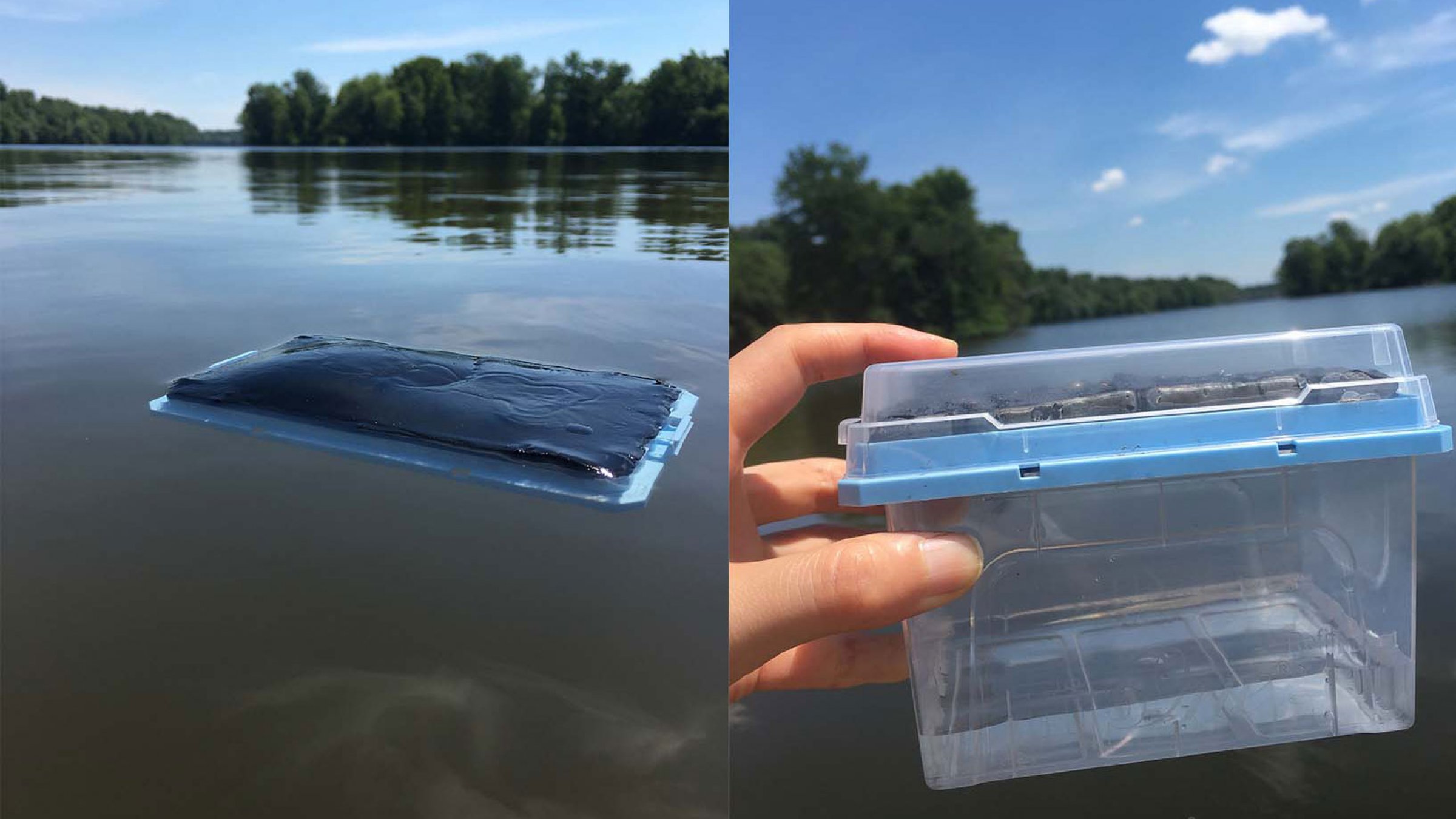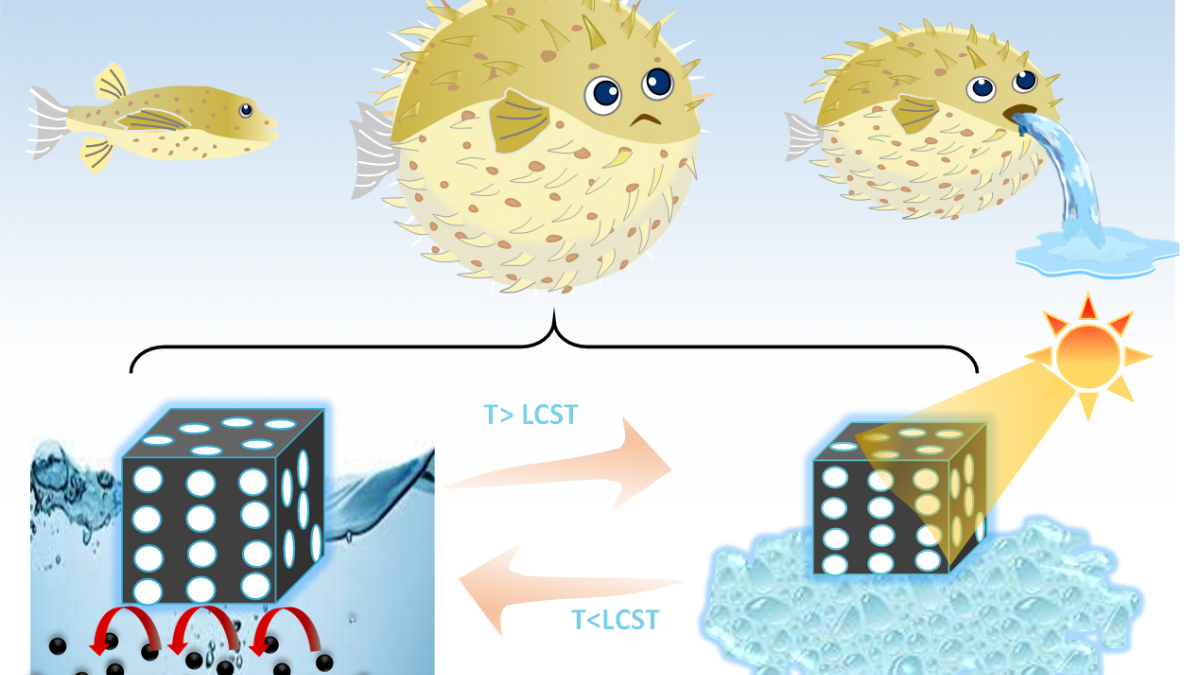
By Catherine Zandonella, Office of the Dean for Research
An invention that uses sunlight to drive water purification could help solve the problem of providing clean water off the grid. The device resembles a large sponge that soaks up water but leaves contaminants – like lead, oil and pathogens – behind. To collect the purified water from the sponge, one simply places it in sunlight. The researchers described the device in a paper published this week in the journal Advanced Materials.
The inspiration for the device came from the pufferfish, a species that takes in water to swell its body when threatened, and then releases water when danger passes, said the device’s co-inventor Rodney Priestley, the Pomeroy and Betty Perry Smith Professor of Chemical and Biological Engineering, an associated faculty member of the Andlinger Center, and Princeton’s vice dean for innovation.
“To me, the most exciting thing about this work is it can operate completely off-grid, at both large and small scales,” Priestley said. “It could also work in the developed world at sites where low-cost, non-powered water purification is needed.”
Xiaohui Xu, a Princeton presidential postdoctoral research fellow in the Department of Chemical and Biological Engineering and co-inventor, helped develop the gel material at the heart of the device.
“Sunlight is free,” Xu said, “and the materials to make this device are low-cost and non-toxic, so this is a cost-effective and environmentally friendly way to generate pure water.”
To demonstrate the device in real-world conditions, Xu took the device to Lake Carnegie on the Princeton University campus.
Xu placed the gel into the cool water (25 degree Celsius, or 77 degrees Fahrenheit) of the lake, which contains microorganisms that make it unsafe to drink, and let it soak up the lake water for an hour.
At the end of the hour, Xu lifted the gel out of the water and set it on top of a container. As the sun warmed the gel, pure water trickled into the container over the next hour.
The device filters water much more quickly than existing methods of passive solar-powered water purification methods, the researchers said. Most other solar-powered approaches use sunlight to evaporate water, which takes much longer than absorption and release by the new gel.
Other water filtration methods require electricity or another source of power to pump water through a membrane. Passive filtration via gravity, as with typical household countertop filters, requires regular replacement of filters.
At the heart of the new device is a gel that changes depending on temperature. At room temperature, the gel can act as a sponge, soaking up water. When heated to 33 degrees Celsius (91 degrees Fahrenheit), the gel does the opposite – it pushes the water out of its pores.

The gel consists of a honeycomb-like structure that is highly porous. Closer inspection reveals that the honeycomb consists of long chains of repeating molecules, known as poly(N-isopropylacrylamide), that are cross-linked to form a mesh. Within the mesh, some regions contain molecules that like to have water nearby, or are hydrophilic, while other regions are hydrophobic or water-repelling.
At room temperature, the chains are long and flexible, and water can easily flow via capillary action into the material to reach the water-loving regions. But when the sun warms the material, the hydrophobic chains clump together and force the water out of the gel.
This gel sits inside two other layers that stop contaminants from reaching the inner gel. The middle layer is a dark-colored material called polydopamine that transforms sunlight into heat and also keeps out heavy metals and organic molecules. With PDA in place, the sun’s light can heat up the inner material even if the actual outdoor temperature is not very warm.
The final external layer is a filtering layer of alginate, which blocks pathogens and other materials from entering the gel.
Xu said that one of the challenges to making the device was to formulate the inner gel to have the correct properties for water absorption. Initially the gel was brittle, so she altered the composition until it was flexible. Xu synthesized the materials and conducted studies to assess the device’s ability to purify water, aided by coauthors Sehmus Ozden and Navid Bizmark, postdoctoral research associates in the Princeton Institute for the Science and Technology of Materials.
Sujit Datta, assistant professor of chemical and biological engineering, and Craig Arnold, the Susan Dod Brown Professor of Mechanical and Aerospace Engineering and director of the Princeton Institute for the Science and Technology of Materials, both associated faculty members of the Andlinger Center, collaborated on the development of the technology.
The team is exploring ways to make the technology widely available with the help of Princeton Innovation, which supports University researchers in the translation of discoveries into technologies and services for the benefit of society.
The study was supported by the Princeton University Presidential Postdoctoral Fellowship Program, the National Science Foundation Materials Research Science and Engineering Center Program through the Princeton Center for Complex Materials (DMR-1420541, DMR-2011750), the Princeton Catalysis Initiative, and the Princeton University Eric and Wendy Schmidt Transformative Technology Fund.
The study, A bioinspired elastic hydrogel for solar-driven clean water purification, by Xiaohui Xu, Sehmus Ozden, Navid Bizmark, Craig B. Arnold, Sujit S. Datta and Rodney D. Priestley, was published in the journal Advanced Materials on March 31, 2021. doi.org/10.1002/adma.202007833
This story originally appeared on the Office of the Dean for Research’s website.